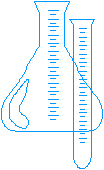
 Science Science |
System of Units  |
||||
| Units & Measurements |
Units and Measurements

Measurements are an integral part of our daily lives. Students, waiting anxiously for a boring lecture to end, very often glance at their wrist-watches, measuring the time remaining to break free! At the vegetable mart, a buyer observes attentively as the seller weighs 2 kilograms of onions on his balance that the buyer had requested for. At an electrical shop, a shopkeeper carefully measures out 3 meters length of electrical wiring for a customer.
Three very important quantities have just been referred to – related to time, mass and length. Note that any measurement consists of two parts – a number and a unit. For the measure of "15 minutes", "15" is the number and "minutes" is the unit. The number and the unit always go together.
A very important aspect of a measurement system is that of a common understanding of what, and how much, the units stand for. If the vegetable seller and the buyer did not have a common understanding of how "heavy" a kilogram is, there would only be endless arguments.
Towards Standards
In the early days of human civilisation, units of measurement which were convenient to use and were easily available, were adopted for measurement purposes. The limbs of man were used as basis for some units of length: for example, the "ell" was the distance from the elbow to the fingertips of an extended hand, the "inch" was the width of the thumb at the base, and the "foot" sprang from the length of a man's foot. However, since there were too many variations between individuals, the situation led to constant confusions and controversies
As trade developed between communities, regions and countries, the need for a common understanding on units of measurement was badly felt. Local and regional governments started establishing standards to serve as measurement guidelines for everyone. With time, different systems came up regionally and countrywide, leading to a final battle with each other, as the standardisation process became a worldwide effort.
A standard refers to a government designated guideline on which a unit of measurement is based. Measuring devices are then manufactured based on the standards. Thus, there is a standard for measuring length called the meter, which was, till very recently, based on a platinum-iridium bar (kept at the Bureau of Weights and Measures in France) having two marks designating the standard distance of one meter. Measuring devices, like the meter sticks used in schools, were manufactured from permanent models, which themselves were based on the standard meter in France.
Bibliography
| Units & Measurements | |||||
 Science Science |
System of Units  |
 High School
High School Mathematics
Mathematics Sets & Basic Operations
Sets & Basic Operations